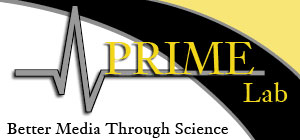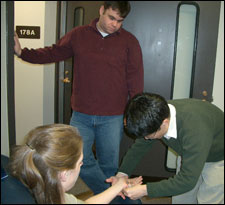Research Reveals Effective Anti-Tobacco Ads Should Either Scare or Disgust Viewers
However, Combining Both Fear and Disgust Appeals in the Same Ad Decreases Viewers’ Attention, Understanding
By Emily Smith
MU News Bureau
Columbia, Mo. (Oct. 24, 2008) — Anti-tobacco public service announcements have been around for decades, designed to encourage people to quit smoking or to refrain from starting. Often these ads try to encourage people to avoid smoking by scaring them with the harmful effects of tobacco use. A new study by Missouri School of Journalism researchers sheds some light on the effectiveness of such appeals.
 Researchers from the Psychological Research on Information and Media Effects (PRIME) Lab at the School examined the effects of two types of content commonly used in anti-tobacco ads, fear and disgust. The researchers found that when ads focused on either fear or disgust, viewers’ awareness and understanding of the message increased. However, if the ads included both fear and disgust, viewers’ recognition and understanding decreased.
Researchers from the Psychological Research on Information and Media Effects (PRIME) Lab at the School examined the effects of two types of content commonly used in anti-tobacco ads, fear and disgust. The researchers found that when ads focused on either fear or disgust, viewers’ awareness and understanding of the message increased. However, if the ads included both fear and disgust, viewers’ recognition and understanding decreased.
“When fear and disgust are combined in a single television ad, the ad might become too noxious for the viewer,” said Glenn Leshner, lead author of the study and co-director of the PRIME Lab. “We noticed several ads in our collection of anti-tobacco public service announcements that contained very disturbing images, such as cholesterol being squeezed from a human artery, a diseased lung, or a cancer-riddled tongue. Presumably, these messages are designed to scare people so that they don’t smoke. It appears that this strategy may backfire.”
There is limited understanding of the cognitive and emotional processes associated with the effects of advertising messages, according to Paul Bolls, co-director of the PRIME Lab. Bolls said the purpose of the study was to examine key characteristics of anti-tobacco ads that influence viewers’ cognitive processes engaged during message exposure, which potentially contribute to the messages’ effectiveness.

“This study provides important insight into how young adults process anti-smoking messages, and it offers practical suggestions for designing effective tobacco prevention messages,” Bolls said. “The way the human mind perceives and processes information in a persuasive message is the very foundation of any desired effect on targeted individuals. The PRIME Lab at MU is dedicated to studying how very specific elements of health campaign messages engage attention and emotion so that messages can be produced that might actually help persuade individuals to adopt healthier attitudes and behaviors.”
The researchers measured the physiological responses of 58 viewers while the viewers watched a series of 30-second anti-tobacco ads. The ads utilized three different kinds of appeals: fear messages that communicated health threats resulting from tobacco use such as lung cancer and heart disease; disgust content that focused on negative graphic images such as dirty insects, blood and organs; or both fear and disgust content.
Electrodes were placed on the viewers’ facial muscles to measure emotional responses. Attention, which was defined as the amount of mental effort participants expended to interpret the messages, was measured by taking participants’ heart rates. To measure recognition, the participants completed a visual recognition task that consisted of watching brief video scenes (1 second) while pressing computer keys to indicate whether or not they believed the scene was from one of the ads they viewed during the experiment.
The study, “Scare ’em or Disgust ’em: The Effect of Graphic Health Promotion Messages,” will be published in the journal Health Communication. Erika Thomas, BJ ’08, is co-author of the study.
Updated: April 30, 2020